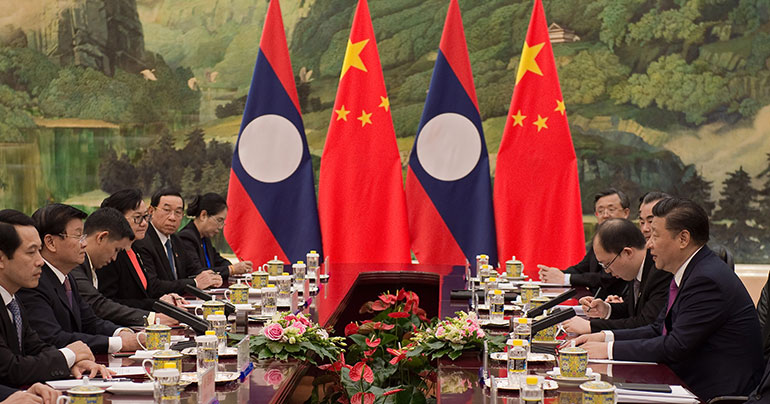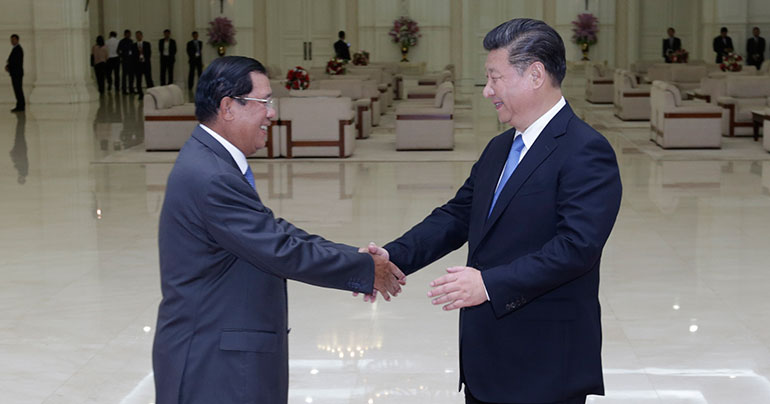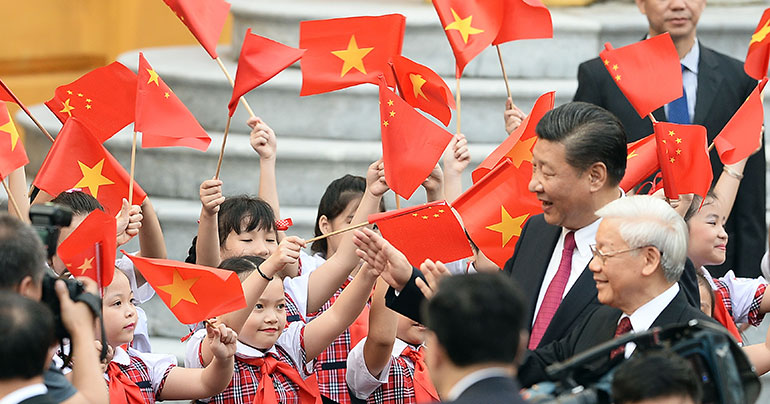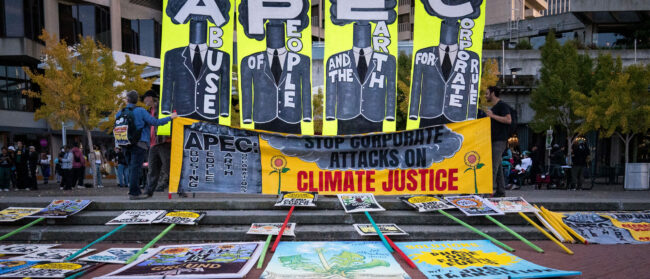Southeast Asia’s longest river winds its way more than 4,300km towards the Pacific, from its origin in the Tibetan highlands to Cambodia and Vietnam, where it flows into a delta. It is called Lancang in China, and Mekong, or “mother of the water”, in the countries downstream. It connects five unequal states along its lower reaches: economically strong Vietnam, its suspicious neighbour Cambodia, self-confident Thailand, politically isolated Myanmar, and Laos, which is still lagging behind.
The river is also the bond that links these five countries with China, their big neighbour to the north. Via the Mekong, Beijing is developing a region in which it builds dams and power stations, roads, railways, ports and factories. Here in Southeast Asia, a world is taking shape in which China is setting the pace, much more dominantly than in Central Asia, Africa or Europe.
Around the globe, Beijing is in the process of securing raw materials, opening up trade corridors and new markets. The rough framework for this is China’s Belt and Road Initiative, also known as the Silk Road Economic Belt, a broad-based development programme originally intended to cover Eurasia but now spreading to other parts of the world.
In countries such as Sri Lanka, Pakistan and Ethiopia, China’s presence is already overwhelming; in Latin American countries, Beijing’s expansion is slow.
In no other region, however, has China’s influence advanced as far as in the Mekong states. This was initially due to their geographical and cultural proximity to China, to historical ties that go back centuries. Above all, though, it is because China is pursuing a strategy in Southeast Asia that goes far beyond each individual project.
China’s place as a new world power can be seen in its relationship with the Mekong region, precisely attuned to the conditions of each country, its history and level of development, its economic needs, its political system, its diplomatic and military preferences.
What exactly is Beijing doing? How does it use China’s special resources and capabilities to consolidate its influence? If no political or economic crisis thwarts the plans of the Chinese leadership, sooner or later, other countries and regions will also face this question.

The debt trap
The journey from China’s border to Muang Xay, the first major city in northern Laos, takes three and a half hours. The route is barely 100km long, leading through villages and forests of bright green rubber trees. Chickens and pigs run across the road. The potholes are as deep as bathtubs.
On every second hill down in the valley, a construction site opens up, where workers can be seen installing concrete bridge piers – and shortly behind them, always a borehole leading into the next mountain.
Here, a Chinese company is building a 414km train line to the capital of Vientiane. It’s a technically challenging project: almost half the line will run through tunnels and a good 60km over bridges. But nobody doubts that it will go into operation as planned in 2021. The journey from the border to Muang Xay will then take 25 minutes, and about three hours to Vientiane.
The arrival of railway workers has turned the provincial town of Muang Xay into a boomtown. All hotels are fully booked, and Chinese off-road vehicles roam the streets.
On the outskirts of the city, where the railway station is to be built, stands a worker shanty town of shipping containers belonging to the railway company. The red flag of China flutters in the wind alongside the Laotian flag. The train line to the capital is divided into six construction phases, said chief engineer Lin, 30; his office alone employs 4,000 Chinese workers.
The arrival of railway workers has turned the provincial town of Muang Xay into a boomtown. All hotels are fully booked, and Chinese off-road vehicles roam the streets.
“A few hundred Laotians also work with him, but not on the construction sites, but during transportation and in the kitchen,” reported Qiu Jixin, 44, the party leader of his unit. As party leader, he is responsible for “ideological education and anti-corruption”, said Qiu. China’s railway sector is notorious for its corruption. The Laos project was helped in 2009 by Beijing’s then-railway minister Liu Zhijun, who has been in prison for bribery and abuse of power for years after being caught in President Xi Jinping’s rampant anti-corruption crackdown.
Nevertheless, the benefits of the railway project are obvious: Laos, the poorest of the Mekong states, has a catastrophic infrastructure. Here people die of banal diseases as bad roads turn trips to the nearest hospital into hours-long slogs. The railway could become the backbone of a transport network that would allow the country to catch up with its neighbours.
But at what cost? When the groundbreaking ceremony took place in 2016, the planners estimated the costs at almost $6 billion. That was almost half of Laos’ economic output at the time – an extremely skewed figure, even measured by the controversial loans China has given other countries. World Bank experts doubt the economic sense of the project.
In order to reduce the costs for the state budget, the government in Vientiane has ceded land to the Chinese railway company: 5 metres left and right along the route, 3 square kilometres at each of the ten planned stations. This pattern is repeated in many countries where China is building roads, railways and ports: Beijing secures land rights in the event that the borrower is unable to pay its debts.
In Laos, Beijing is acting as a builder that is solving a problem that no other country could solve so quickly and efficiently. At the same time, China is creating a dependency from which its partner will not be able to free itself in the foreseeable future. Laos is stuck in China’s debt trap.
Kra Canal
It may take decades, but if it were up to China, the railway to Laos would not end in Vientiane. For Beijing, it is part of an even more advanced project, a pan-Asian transport network that could one day reach as far as Singapore and include not only roads and railways, but also a major canal.
In Thailand’s capital, Bangkok, there are influential men who support Beijing in this plan, some of whom are members of the Thai-Chinese Cultural and Economic Association. Its secretary general, Paisal Puechmongkol, explained how the association came about 40 years ago: “After the defeat of the USA in the Vietnam War, Thailand was looking for an ally against the strengthened Vietnam. China is very suitable for this.”
One of the projects Beijing’s friends in Thailand have dedicated themselves to is one that geo-strategists are working on with increasing urgency: the so-called Kra Canal, or Thai Canal, an artificial link between the Indian Ocean and the Pacific.
So far, shipping traffic between the two oceans, including a good 80% of China’s oil imports, passes through the Strait of Malacca. But this sea route is reaching the limits of its capacity: almost 100,000 ships pass through the Malacca Strait every year, and in a few years, the maximum capacity of around 1.2 million ships could be reached. The idea of an accident or a military conflict with the US closing this bottleneck is a primal fear of Chinese politicians.
Beijing knows that it has a self-confident, economically potent partner in Thailand that it cannot put under pressure as easily as Laos
“The Kra channel would solve this and many other problems,” said economist Pakdee Tanapura of the China Friends Association. A breakthrough at the isthmus of Kra, where Thailand is only 40km wide, will not only create a new sea route, but will save the world’s shipping companies millions in fuel costs.
Pakdee estimated the construction time at eight years and the cost of the project at $20 billion. The designs he shows were created by Chinese construction companies. Thailand and China are said to have already signed a memorandum of understanding on the project, but Beijing, Pakdee said, is wisely advertising the canal behind the scenes.
There have been two major central criticisms of the project: the canal, wherever it is built, would separate Thailand’s Buddhist north from its restive Muslim south – a major problem for Thailand’s internal security.
“India is also afraid of the canal,” Paisal pointed out. New Delhi is concerned about China’s influence in the region, and Bangkok must take this into account.
So the plan is to proceed cautiously, including India, Tokyo and Seoul. Japan and South Korea also obtain most of their oil imports from the clogged Strait of Malacca. The debate over the Kra Canal shows an unfamiliar side of the power-conscious Beijing. It undoubtedly supports a project from which China would benefit massively. But the leadership in Beijing knows that it has a self-confident, economically potent partner in Thailand that it cannot put under pressure as easily as Laos – or Cambodia.

“Sihanoukville, that is no longer Cambodia”
Three things are forbidden when entering a casino in Sihanoukville, the seaside resort in the south of Cambodia: weapons, drugs and alcohol. The prohibitions are written in Chinese so customers can understand them. Gambling is illegal for Cambodians, so they are not allowed to enter casinos.
“If it were up to me, then we would also forbid the Chinese to drive here ruthlessly and build skyscrapers,” said a driver who called himself Chanly. “Again and again, it comes to fatal accidents. I am afraid as soon as my wife sits down on the moped. And then there’s this,” he said, pointing to one of the half-finished 30-storey towers that have turned the city centre into one big construction site.
Sihanoukville, built in the 1950s and named after Cambodia’s former king, has turned from a quiet beachside town into a “Chinese colony”, as Chanly put it. Every year, the number of Chinese tourists in the city doubles, most of them coming just to play.
“Sihanoukville, that is no longer Cambodia,” said Vannarith Chheang, 40, from the Institute of Strategic Studies in the capital of Phnom Penh. “China’s embassy is working around the clock to improve its country’s bad image. Eight out of nine Cambodians have a negative image of China.”
But their head of government has a softer spot for the Chinese: as he wrote on his Facebook page before the July election, 33-year ruler Prime Minister Hun Sen found enthusiastic support in China’s leaders.
“China is growing so fast that Europe and the USA can hardly keep up with developing strategies for dealing with the new world power.”
Vannarith Chheang, Institute of Strategic Studies
Hun Sen won the vote, and China had played its part: Beijing’s ambassador had taken part in an election campaign by the ruling party, and the National Election Committee received a $20m donation from the Chinese. In April 2017, Hun Sen had recommended a book by China’s head of state, Xi Jinping, to “the officials, professors and students” of his country to read. Shortly before the election, China’s defence minister was in Cambodia calling the country a “faithful friend” and promising $100m in military aid.
Researcher Chheang explained Cambodia’s close relationship with Beijing using a political argument. The country historically has felt threatened by two strong neighbours, Thailand and Vietnam. “In this situation, China is a natural ally,” he said. “In addition, the West doesn’t know what it actually wants in this region. China is growing so fast that Europe and the USA can hardly keep up with developing strategies for dealing with the new world power. Small states in Southeast Asia therefore have no choice but to conform to reality.”
In none of the Mekong countries does Beijing interfere politically to the extent that it does in Cambodia. China’s approach shows that it is taking the special conditions of each individual state into account – even if through a supposed democratic election campaign like it would never happen in China itself.

Vietnam: balancing act
Shortly before its mouth in the Mekong Delta, two large bridges span the two main arms of the river. One was built by Vietnam with the Japanese, the other by Australia.
No other state on the Mekong is as difficult for China as Vietnam, its neighbour and former enemy. In 1979, the two socialist brother states carried out a brief, bloody border conflict. The question was who would assume the leading role in the region after the Vietnam War. Since then, relations have been turbulent.
China is using every means at its disposal to establish an economic presence in Vietnam. Chinese companies are building an underground railway in Hanoi, a huge coal-fired power station is currently in operation on the southeast coast and dozens of Chinese textile factories have settled in the industrial belt around Ho Chi Minh City. Beijing is Vietnam’s largest trading partner.
Nonetheless, anti-Chinese protests continue. In June, hundreds of Vietnamese demonstrated against a law promising long-term leases to foreign investors, including China. Four years ago, thousands took to the streets against the relocation of a Chinese oil platform in the South China Sea. In 2016, a border official wrote the words Fuck you to a Chinese tourist in her passport – on a page showing a map highlighting Beijing’s claim to an area in the sea that Vietnam also wants.
Vietnam cooperates economically with China. But with 95 million inhabitants and a booming industry, the country is not at the mercy of China’s superiority.
“In Vietnam, resistance to China never comes from politicians,” said regime critic Nguyen Chi Tuyen, 42, who lives in Hanoi. Here, it is always the people who drive the government before them.
What he fears about China is not only the economic superiority and the imperial claim. “Much greater is our fear of China’s authoritarian model, the technically sophisticated surveillance state,” said Tuyen. This model is attractive to the leadership of Vietnam’s state party. “Our government is still a long way from being able to monitor its citizens as closely as it does in Beijing. But I, too, now have to think carefully about who I will meet with.”
The ideological similarity between the two state parties carries is difficult to assess. China’s influence on Hanoi is limited. Vietnam cooperates economically with China. But with 95 million inhabitants and a booming industry, the country is not at the mercy of China’s superiority.
Since China is not yet strong enough to assert its territorial claims in the South China Sea militarily, it indirectly exerts pressure on Hanoi using its neighbours to the west. Beijing’s massive investments in Laos and Cambodia are paying off: Laos is still balanced in the island dispute, while Cambodia is clearly on China’s side.
Indirect funds are also available to Vietnam. In March, Hanoi allowed a US aircraft carrier to dock in Vietnam for the first time since the end of the Vietnam War.
The signal was clear: Vietnam is looking for allies to balance out China’s strategic looming presence in Southeast Asia.
Lancang-Mekong Cooperation
One of the most successful Chinese films of all time is a thriller called Operation Mekong. It is based on a 2011 incident in which river pirates attacked two Chinese cargo ships on the Mekong and killed all 13 crewmembers. A drug boss from Myanmar who was identified as the mastermind was extradited to China and executed there. Since then, Chinese police have been patrolling the lower reaches of the Mekong alongside authorities from Thailand, Laos and Myanmar. And although four of the neighbouring states had already been working together for decades in a loose alliance called the Mekong River Commission, Beijing founded a new organisation in 2015 that now includes China and the five Mekong countries: the Lancang-Mekong Cooperation.
China’s control over Southeast Asia is no longer limited to building railways, canals, casinos and power plants. Along the Mekong, Beijing’s development of power takes on a dimension of explicit political and strategic goals. China’s leadership is even prepared to break with a decades-old doctrine: the principle of not interfering in the political crises
of other states.
Beijing has not failed to notice that Myanmar’s de facto Western head of government, Aung San Suu Kyi, would not support the Rohingya after the outbreak of the mass violence against the Muslim minority. As soon as the first disappointed speeches by Western politicians about the 1991 Nobel Peace Prize winner had faded away, Suu Kyi was received in Beijing by China’s Xi Jinping. Foreign Minister Wang Yi proposed a three-stage plan to solve the crisis and offered his country as a mediator – a novelty in China’s recent history.
Anyone who has observed China’s involvement in Africa, the Middle East and the Indian Ocean can see a pattern: where others retreat, Beijing aggressively steps in. This was the case when India and EU states turned their backs on Sri Lanka during its civil war; when Saudi Arabia and Israel alienated themselves from the US under Barack Obama; and whenever Washington’s relationship with Pakistan cools down.
In Southeast Asia, this pattern is likely to repeat itself, as Europe and the US deal with their own crises, lacking strategic foresight.
None of the Mekong countries is a constitutional state or a Western democracy – not the one-party dictatorships in Laos and Vietnam, not the militarily dominated regimes in Thailand and Myanmar, not the increasingly authoritarian Cambodia under the leadership of the autocrat Hun Sen.
But in all of these countries, there are people who are afraid of a world order dominated by China.
© 2018 Spiegel Online Distributed by The New York Times Syndicate


